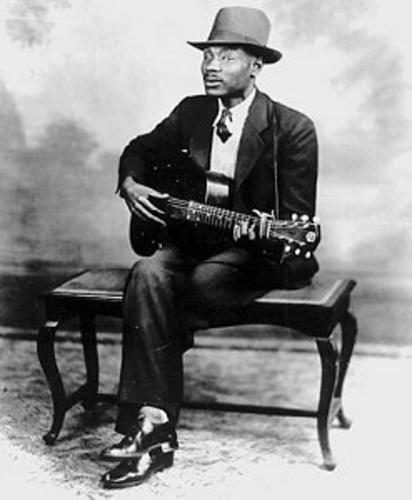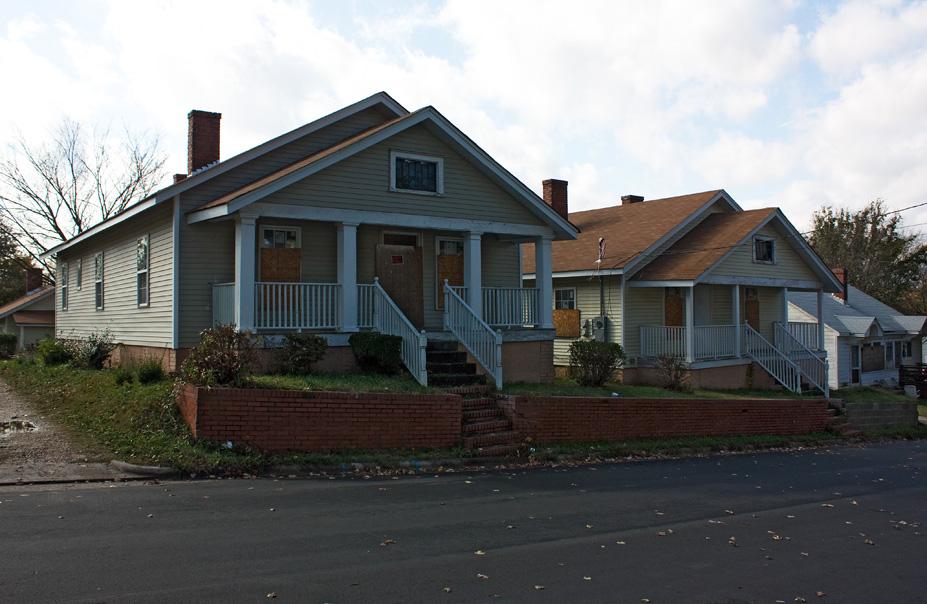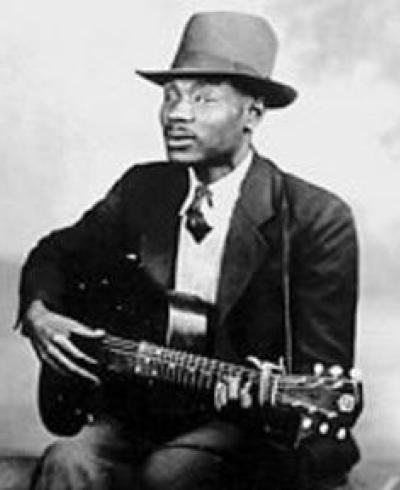1971
The most well-known of Durham's Bluesmen is 'Blind Boy Fuller'. Fuller, née Fulton Allen, was born on July 10, 1907 in Wadesboro, NC. He was one on ten children, and early in his childhood moved to Rockingham, NC, after the death of his mother. In 1926, Allen married Cora Mae Martin; the following year, he began to lose his eyesight, and turned to busking on street corners with this guitar as a way to earn money. Allen traveled to Winston-Salem and Danville, VA, playing at tobacco warehouses. In 1928, then completely blind, he made his way to Durham.
Allen often played in the tobacco warehouse district to earn money; street vendors, musicians, and retail establishments all were interested in tapping the tobacco farmer who was newly flush with cash from the tobacco sale. He also played along the part of Hayti also known as 'Mexico', along East Pettigrew Street.
In 1935, James Baxter Long, who managed a record store in Burlington, and the United Dollar Store in Durham noted Fuller's talent. He secured Allen a recording session with the American Recording Company (ARC) along with 'Blind' Gary Davis and washboard player/guitarist George Washington. It was Long who coined the name 'Blind Boy Fuller' as a better moniker for selling records; Long also named Washington 'Bull City Red', which reportedly referred to Washington's skin color.
The musicians recorded several tracks in New York City, including "Rag, Mama, Rag" and "I'm a Rattlesnakin' Daddy." Over the next five years Fuller recorded ~135 'sides', his recordings appearing on several labels. In April 1936, Fuller recorded ten solo performances, and also recorded with guitarist Floyd Council. In 1937, he auditioned for talent scout Mayo 'Ink' Williams and recorded for the Decca label, but then returned to ARC. Later in 1937, he made his first recordings with harmonica player Sonny Terry, recording "Bye Bye Baby Blues."
Fuller is often described as a "sharp dresser" who had a "fiery temper" and always carried a .38 pistol with him. In 1938, he was imprisoned in the Durham County Jail for shooting his wife in the leg. His wife evidently recovered and forgave him.
However, the incarceration caused him to miss John Hammond's "Spirituals to Swing" concert in New York City that year. Sonny Terry who went in his stead, sparking the beginning of a long 'folk music' career.
Fuller recorded again that same year in Columbia, SC, producing "Big House Bound" about his time in the Durham jail. He recorded again with Washington and Terry in Memphis in 1939. Fuller's last two recording sessions took place in New York City during 1940. Fuller refused admission to the hospital, and was cared for at his home at 904 Massey Avenue by his wife. He died on February 13, 1941 following complications from surgery for cystitis. He is buried in Grove Hill Cemetery. Read a bit more about Fuller's final resting place (and those of other bluesmen) at his entry on the Dead Blues Guys site.
While I'm not qualified to analyze Fuller's work, this is one opinion from his Wikipedia entry:
"His style of singing was rough and direct, and his lyrics explicit and uninhibited as he drew from every aspect of his experience as an underprivileged, blind Black person on the streets -- pawnshops, jailhouses, sickness, death -- with an honesty that lacked sentimentality. Although he was not sophisticated, his artistry as a folk singer lay in the honesty and integrity of his self-expression. His songs contained desire, love, jealousy, disappointment, menace and humor."
You can listen to an excerpt of Fuller's music at this site, or here is a sampling of Blind Boy Fuller music on iTunes.
A prolonged effort to recognize Fuller with a historical marker culminated in the placement of a state historic marker on Fayetteville St (beside the Stanford L. Warren library) and a city historic marker along the American Tobacco Trail near Fayetteville St. and the cemetery where Fuller was buried. When the city marker was unveiled, Nick Tennyson (then mayor of Durham) proclaimed June 16, 2001 as "Blind Boy Fuller Day".
Fuller's house, unfortunately, has seen better days, and nothing marks the house at 904 Massey Ave. other than assorted pieces of plywood boarding up possible points of ingress.
Blind Boy Fuller house, on the left, 11.15.08
Find this spot on a Google Map.
35.978654,-78.893432





Comments
Submitted by John (not verified) on Fri, 12/5/2008 - 7:52pm
Thank you, Gary. Here's more background on local efforts to recognize Blind Boy Fuller.
~John Schelp
Five strangers' efforts pay off as Durham honors Blind Boy Fuller
News & Observer, 16 June 2001
North Carolina will patch a hole in its cultural memory today by remembering the late Blind Boy Fuller, once the best-known Piedmont blues musician in the state.
Fuller, whose real name was Fulton Allen, used to play his guitar and sing for change outside Durham's bustling downtown tobacco warehouses in the 1930s and '40s. Once he started making records, he became a giant of the Piedmont blues style -- just as Muddy Waters is to Chicago blues or Bill Monroe is to bluegrass, music experts say.
The city of Durham will unveil a historic marker honoring him at 10 a.m. today. Fuller, 60 years dead, might enjoy the hoopla: music by Tar Heel bluesman Lightnin' Wells and other musicians, a speech by the mayor and tributes from musicians who were shaped by his work. The moment will mark a triumph for the five strangers who banded together to resurrect Fuller's memory in late 1999. Today will be the first time they have all met. To celebrate this Depression-era talent, they worked mostly through e-mail.
It started in 1999 with Gaile Welker of Greensboro, a blues fanatic who was researching Fuller's life. She saw an Internet story about a Durham neighborhood group's cleanup of a cemetery and sent an e-mail message to the group's president to ask whether Fuller's grave had been found. The president, John Schelp, who works in Research Triangle Park, had never heard of Fuller but agreed to meet Welker at Durham's Carolina Theatre to see a film about another local blues player.
In the lobby, they met Jim Walton of Raleigh and Darrell Stover of Durham, both neighborhood activists and blues fans. Later, the group recruited Glenn Hinson, chairman of the folklore curriculum at the University of North Carolina at Chapel Hill.
Together, they persuaded city leaders to proclaim today "Blind Boy Fuller Day" and erect the marker on the American Tobacco Trail near his grave. They got the state to agree to put up another marker later this summer on Fayetteville Street and raised money for an engraved brick celebrating Fuller for a sidewalk in Wadesboro, where he was born.
All of this will please Fuller fans, blues artists and scholars from England, Australia, Germany, Italy and other countries who wrote letters supporting the markers. Some said that until now, Fuller had been forgotten in the town where he lived, performed and died.
Fuller was discovered when James Baxter Long, the manager of the Dollar Store on Club Boulevard, saw him performing at a tobacco warehouse. Months later, in 1935, Long, who was dabbling in the music industry, loaded Fuller and two other Durham bluesmen -- Gary Davis and "Bull City Red," whose real name was George Washington -- in his car and drove to New York to make Fuller's first record. Fuller, who had been on welfare, became the biggest commercial success of all Piedmont bluesmen. He recorded 130 songs between 1935 and 1941. One record, "Step It Up and Go," sold more than half a million copies.
Those records were the most popular ones in jukeboxes in African-American hangouts across the state, said Lightnin' Wells, a folk and blues player who tours internationally. Ragtime and jazz can be heard in the chords of Fuller's "Rag, Mama, Rag"; sexy insinuation in "I Want Some of Your Pie"; and a bit of prayerful gospel in his version of "Precious Lord. "Later, Fuller's music influenced artists such as Bob Dylan, Woody Guthrie and Brownie McGhee, Wells said.
Many North Carolina artists play his style and his songs, including Etta Baker, Algia Mae Hinton, John Dee Holeman and George Higgs.
So it is about time Durham remembered Blind Boy Fuller, Schelp said: "Every town in North Carolina has a monument to war. Very few have monuments to people other than governors and military generals. This is a monument to the core of Durham's history."
Submitted by Andrew Edmonds (not verified) on Fri, 12/5/2008 - 8:41pm
Frank Stasio's The State of Things produced a show about Blind Boy Fuller earlier in the year. Guest guitarist Boo Hanks was especially fun to hear, singing Fuller's risque numbers.
Submitted by phil (not verified) on Fri, 12/5/2008 - 9:57pm
Fitting in with the Endangered Durham theme, Blind Boy Fuller sings the line "someday you're going to be sorry you mistreated me" in this song:
http://www.youtube.com/watch?v=D-m9qT8USek
Submitted by Barry (not verified) on Tue, 12/9/2008 - 3:48am
from the picture, it looks like all three houses are boarded up.
how durham is that?
Submitted by Steve (not verified) on Tue, 12/9/2008 - 1:57pm
Waaaay cool post!
BBF was also known to have lived at a few other places over the years. Bruce Bastin's books ("Red River Blues" and "Crying for the Carolines") are great sources on BBF.
The Southern Folklife Collection at UNC has a bunch of info on him as well as many (if not all) of his original recordings.
Add new comment
Log in or register to post comments.